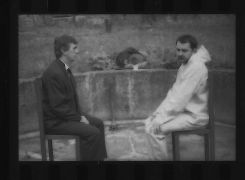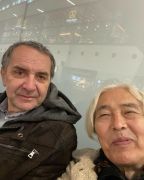Towards the end of the 1980s, different activities both in unofficial culture and in the so-called “grey zone” emerged, and greatly influenced, determined and marked the course of the beginning of the 1990s. Enormous dynamics of emerging artistic groups, associations, unions and communities after the 17th of November, 1989, created the potential and hope for a vibrant artistic and, more generally, cultural scene in Czechoslovakia.
The political climate was favorable, though only for a short period of time. Since the beginning of 1993 onwards, there was a gradual but visible decline of cultural projects and activities, especially outside the state institutions. This process continued until 1998/1999. In 1993 Czechoslovakia split into two separate states, and new borders were established. Crossing the border shortly after the old regime collapsed was hindered again with obstructions, and this became also a phenomenon of this period. The shock from the split of Czechoslovakia and reactivation of the contacts did not happen automatically.
Of course you can name some individual "success stories" of the artist's career after 1989. But in terms of the general situation after the vivid years before 1992/93, this period bears symptoms of decline. I don't want to link this necessarily to myself, I am referring to memories of my friends and colleagues. I worked for the magazine Profile of Contemporary Art, which was founded in 1991. Gradually declining funding from the state from 1993 onwards led to its suspension in 1995 until 1999. Fortunately the journal was reborn again in 2000 and exists until now.
During the 1990s, an important role was played by the branch of the Open Society Fund, The Soros had founded the Center for Contemporary Art (SCCA). They provided artists with a grant system, organized annual exhibitions and helped to promote Slovak artists internationally. I think that among the highlights of the activities connected to the SCCA were several large exhibitions organized in collaboration with Slovak National Gallery, such as The Sixties in Slovak Art (1996), The 20th Century in Slovak Art (2000), and Action Art 1965-1989 (2001). These exhibitions covered a large part of the history of modern and contemporary Slovakian art.
In my subjective opinion, the most significant activity of the 1990ies was the Transart Communication festival, which started already in 1988 in Nové Zámky. It played an important role even in the European context and until now it is still considered one of the longest existing performance festivals in the international context (even though it changed its name). More than 400 international artists participated there and its influence can even be traced to the a similar festival in Japan. This festival (beside the program of Society for Unconventional Music - SNEH), through participating artists, became one node of an emerging new network. Hermit became part of it as well.
The activities in Plasy monastery started at the same time when we slowed down our activities in Bratislava because the previous years, from 1990 till 1992, were too intensive. I arrived at Plasy together with Phil Niblock for the first time in the summer of 1992. Plasy was an impressive site and Miloš Vojtěchovský succeeded in inviting artists of a similar kind as we did at the Society for Unconventional Music (SNEH) in Bratislava. Some of them we met at different art events across Europe. The feedback we received from the participants about Hermit was superlative and inside the European “unconventional art community” it became a platform, which in turn fostered different approaches towards contemporary art than it was normally presented in museums and galleries.
More collaboration with Hermit came after 1996 when I participated in the workshop Sub Rosa (a presentation of the book, Avalanches). In 1998, I came for the workshop Rites de Passage (with Peter Kalmus) and the same year again to shoot two experimental films there. And finally, in August of the same year I accompanied the Australian composer and musician, Ross Bolleter, who performed solo with accordion and together with Michael Delia in one of the chapels of the convent. To sum it up, we in Slovakia were very much and continuously aware of the activities in Plasy.
Michal Murin, September, 2023
Examples of Murin's projects and activities in the 1990s:
1987 – 1993: The Boulder - Balvan (Experimental theater/performance group), Bratislava, 1989 – 1996: Society for Non-Conventional Music, 2011 – 2018: Transmusic Comp. 1989-: Evenings for New Music, 1987-: Veni ensemble, 1991: San Francisco Performance Art Festival, 1991: Festival intermediálnej tvorby, John Cage (exhibition in Slovak National Gallery and performance in Slovak Philharmony, 1992: Hills and Mills exhibition in Bratislava, 1994: Music Solarium festival, 1995 – 1996: BeeCamp, 1995 – 2000: Sound Off festival, 2000- web RadioArt – Slovenský rozhlas, 1988 -: Festival of experimental art later TransArt Communication Nové Zámky, Wiesbaden: Ben Patterson, Budapest: MaMű Gallery, Magyar Műhely (art magazine), Brno: Ticho (art magazine), Skleněná louka, Střepy Gallery, festival performancie A.K.T. Brno, Ostrava: festival Malamut, Praha 1991: Festival People to People (Linhartova nadace), Akční Praha, Schrattenberg: Symposiums, Berlin: Institut Unzeit (Mathias Osterwaltd), Jon Rose (Rosemberg Museum), Eindhoven: Paul Panhuysen and Het Apollohuis, Gent/New York: Experimental intermedia and Phil Niblock.

